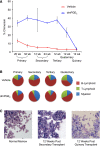Prostaglandin E2 enhances long-term repopulation but does not permanently alter inherent stem cell competitiveness
- PMID: 24047650
- PMCID: PMC3811174
- DOI: 10.1182/blood-2013-07-515288
Prostaglandin E2 enhances long-term repopulation but does not permanently alter inherent stem cell competitiveness
Abstract
Hematopoietic stem cell (HSC) transplantation is a lifesaving therapy for malignant and nonmalignant hematologic diseases and metabolic disorders. Although successful, hematopoietic transplantation can be hindered by inadequate stem cell number or poor engrafting efficiency. To overcome these deficits, we and others have previously reported the HSC-enhancing ability of a short-term exposure of prostaglandin E2 (PGE2); this strategy has now progressed to phase 1 clinical trials in double cord blood transplantation. To further analyze the short- and long-term effects of HSC exposure to PGE2, we followed the repopulation kinetics of PGE2-treated hematopoietic grafts through 5 serial transplantations and compared inherent long-term competitiveness in a HSC head-to-head secondary transplantation model. Treatment with PGE2 did not result in a long-term increase in HSC competitiveness, lineage bias, or enhanced proliferative potential, demonstrating that pulse exposure to PGE2 results in transient increases in HSC homing and engraftment potential.
Figures


Similar articles
-
Prostaglandin E2 enhances hematopoietic stem cell homing, survival, and proliferation.Blood. 2009 May 28;113(22):5444-55. doi: 10.1182/blood-2009-01-201335. Epub 2009 Mar 26. Blood. 2009. PMID: 19324903 Free PMC article.
-
Newly emerging roles for prostaglandin E2 regulation of hematopoiesis and hematopoietic stem cell engraftment.Curr Opin Hematol. 2010 Jul;17(4):308-12. doi: 10.1097/MOH.0b013e32833a888c. Curr Opin Hematol. 2010. PMID: 20473159 Review.
-
Pulse exposure of haematopoietic grafts to prostaglandin E2 in vitro facilitates engraftment and recovery.Cell Prolif. 2011 Apr;44 Suppl 1(Suppl 1):22-9. doi: 10.1111/j.1365-2184.2010.00726.x. Cell Prolif. 2011. PMID: 21481039 Free PMC article.
-
Pharmacologic increase in HIF1α enhances hematopoietic stem and progenitor homing and engraftment.Blood. 2014 Jan 9;123(2):203-7. doi: 10.1182/blood-2013-07-516336. Epub 2013 Oct 28. Blood. 2014. PMID: 24167196 Free PMC article.
-
Prostaglandin E2: making more of your marrow.Cell Cycle. 2007 Dec 15;6(24):3054-7. doi: 10.4161/cc.6.24.5129. Epub 2007 Oct 3. Cell Cycle. 2007. PMID: 18075310 Review.
Cited by
-
Extracellular Adenosine Triphosphate (eATP) and Its Metabolite, Extracellular Adenosine (eAdo), as Opposing "Yin-Yang" Regulators of Nlrp3 Inflammasome in the Trafficking of Hematopoietic Stem/Progenitor Cells.Front Immunol. 2021 Jan 29;11:603942. doi: 10.3389/fimmu.2020.603942. eCollection 2020. Front Immunol. 2021. PMID: 33584673 Free PMC article. Review.
-
Thrombopoietin treatment of one graft in a double cord blood transplant provides early platelet recovery while contributing to long-term engraftment in NSG mice.Stem Cells Dev. 2015 Jan 1;24(1):67-76. doi: 10.1089/scd.2014.0294. Stem Cells Dev. 2015. PMID: 25137252 Free PMC article.
-
Biomechanical Regulation of Hematopoietic Stem Cells in the Developing Embryo.Curr Tissue Microenviron Rep. 2021 Mar;2(1):1-15. doi: 10.1007/s43152-020-00027-4. Epub 2021 Jan 26. Curr Tissue Microenviron Rep. 2021. PMID: 33937868 Free PMC article.
-
Leukocyte Trafficking and Regulation of Murine Hematopoietic Stem Cells and Their Niches.Front Immunol. 2019 Mar 5;10:387. doi: 10.3389/fimmu.2019.00387. eCollection 2019. Front Immunol. 2019. PMID: 30891044 Free PMC article. Review.
-
Endothelial Cells Promote Expansion of Long-Term Engrafting Marrow Hematopoietic Stem and Progenitor Cells in Primates.Stem Cells Transl Med. 2017 Mar;6(3):864-876. doi: 10.5966/sctm.2016-0240. Epub 2016 Oct 14. Stem Cells Transl Med. 2017. PMID: 28297579 Free PMC article.
References
-
- Pelus LM. Prostaglandin E: biphasic control of hematopoiesis. In: Cohen MM, editor. Biological Protection with Prostaglandins. Boca Raton: CRC Press Inc; 1985. pp. 45–55.
-
- Pelus LM. Modulation of myelopoiesis by prostaglandin E2: demonstration of a novel mechanism of action in vivo. Immunol Res. 1989;8(3):176–184. - PubMed
Publication types
MeSH terms
Substances
Grants and funding
LinkOut - more resources
Full Text Sources
Other Literature Sources
Medical

